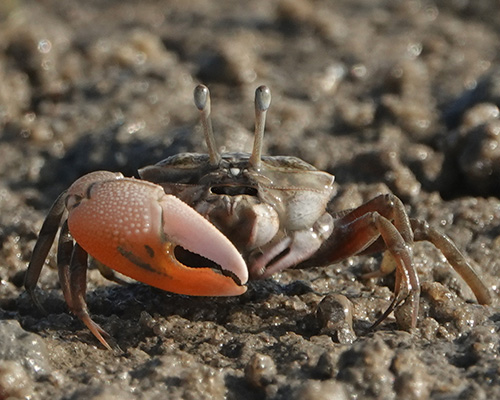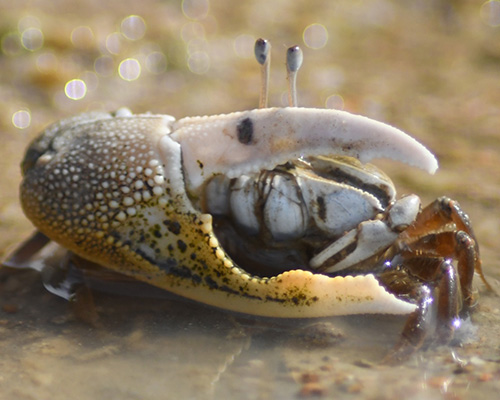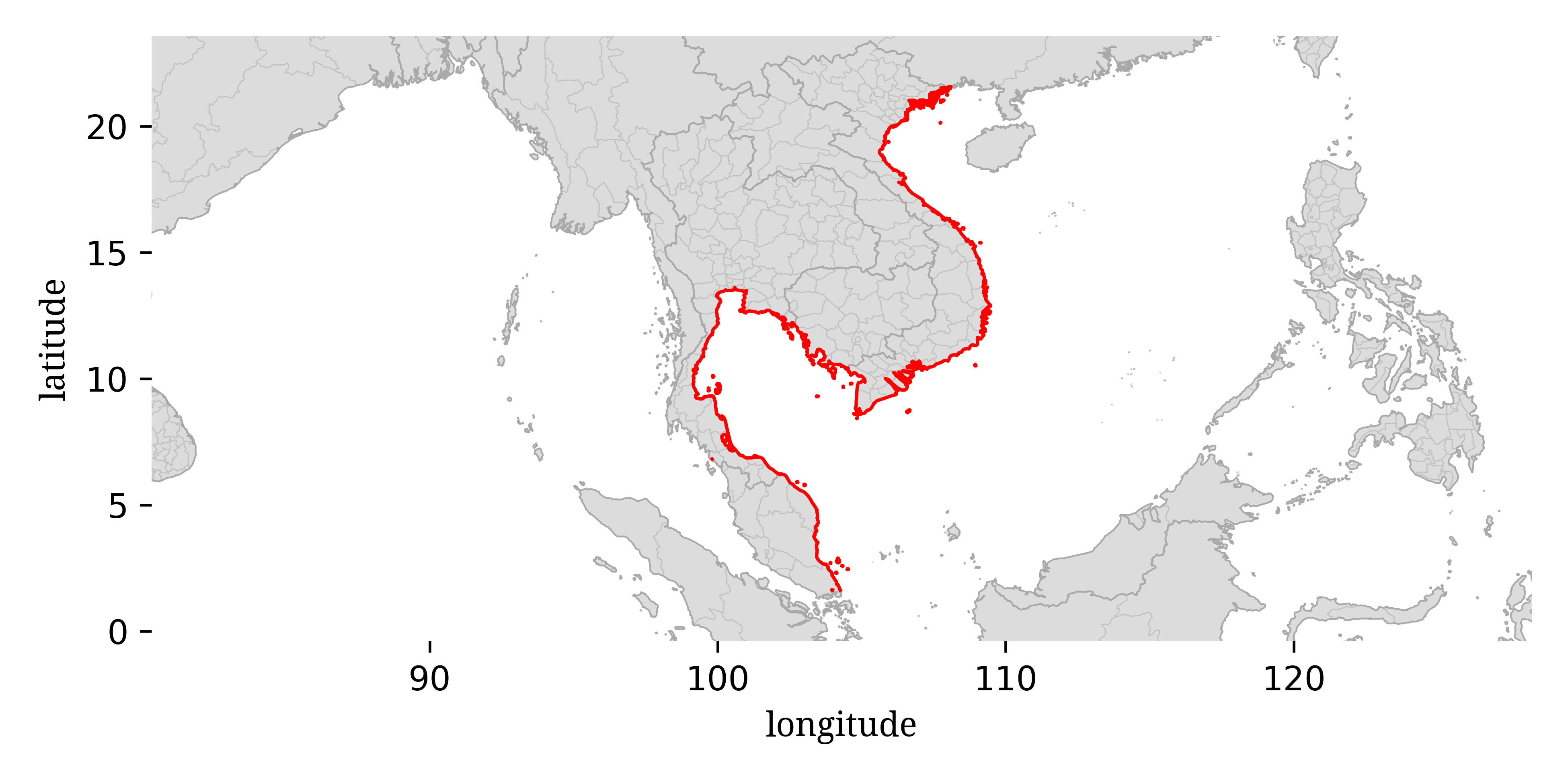
This guide is designed for identification “in the field” where you might be looking at live crabs by eye or through binoculars or from photographs. I will generally try to avoid characters that will require you to physically catch the crab, although I may mention a few for secondary verification. It does not include the more strict taxonomist-style characters that may only be visible under a microscope or via dissection. It is also assumed that the individuals are living, as death (and even capture) can cause dramatic color change.

This is a guide to the fiddler crabs of the eastern Malay Peninsula (the east coasts of Thailand and Malaysia, excluding Johor), as well as Cambodia and Vietnam. As with the western side of the peninsula, this region has a complex and potentially confusing faunal assemblage, with as many as 16 possible species present:
The distribution of various species within this region is not particularly well established, in part because of a general lack of occurrence data in Cambodia and (to a lesser extent) Vietnam, areas in which it is likely some of the transition between more northern and southern forms occurs.
A number of features can be used to distinguish among these species, but a good place to start is to look at the distance between the base of the eyestalks. Fiddler crabs tend to split into two groups, those with the eyestalks very close together (“narrow front”) and those with the eyestalks separated a bit more (“broad front”). Five of these species (Austruca annulipes, Austruca lactea, Austruca perplexa, Austruca triangularis, and Paraleptuca splendida) are broad front species, while the other 11 (Gelasimus borealis, Gelasimus tetragonon, Gelasimus vocans, Tubuca acuta, Tubuca arcuata, Tubuca dussumieri, Tubuca forcipata, Tubuca paradussumieri, Tubuca rhizophorae, Tubuca rosea, and Tubuca typhoni) are narrow front species. Note that the carapace between the eyestalks appears pinched together in the narrow front species, but more trapezoidal in the broad front species.
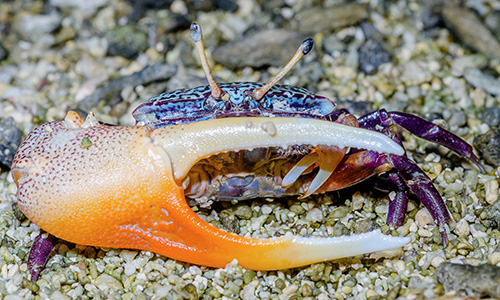
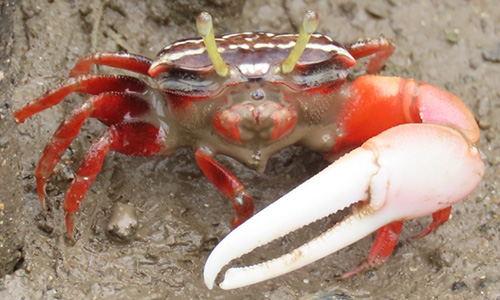
The carapace of Austruca lactea is generally either white or white with black (dark brown) markings, generally a small scattered speckling of black, frequently with a few thin stripes (kind of like a Rorschach test). In rare occasions the carapace will be more black than white. The legs are generally either white or red (ranging from dark to bright). Eyestalks are generally white or gray. The major cheliped is generally entirely white, or with yellow extending from the arm up into the hand of the claw, but usually still white along the fingers.
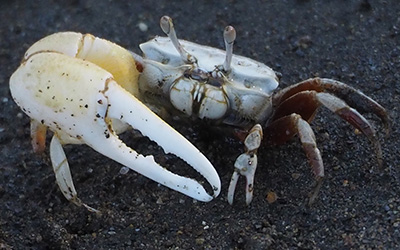

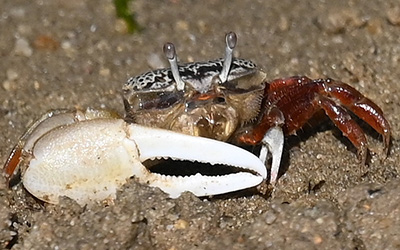
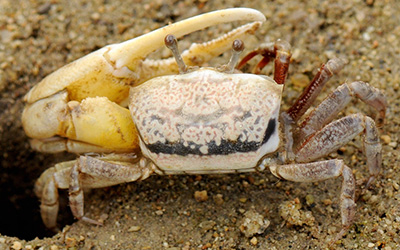

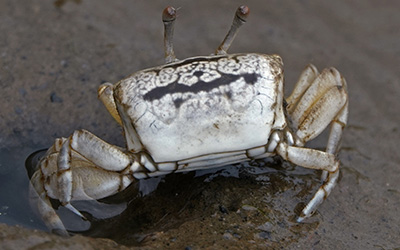
Austruca perplexa can be readily confused with Austruca lactea as they can be very similar in appearance. Austruca perplexa is primarily distinguishable from Austruca lactea by differences in the pattern of the carapace (as well as some very subtle shape differences). Both species have a carapace that is generally black and white. Austruca lactea tends toward having a claw that is mostly white, while Austruca perplexa frequently has a claw that is mostly yellow, but both species can have solid white claws. Austruca lactea will often have dark red legs, while Austruca perplexa rarely does.
The pattern of the black and white pattern on the carapace of the two species has a somewhat subtle difference. Austruca perplexa tends to appear to be more striped, with large, moderately distinct black and white bands, while Austruca lactea tends to be more marbled, without the banding and less distinct boundaries between the colors. On average, Austruca lactea tends toward more white (frequently solid white), while Austruca perplexa tends toward more black (almost never entirely so), but this is not a universal pattern and there is overlap with both species occasionally having entirely white or mostly black carapaces.
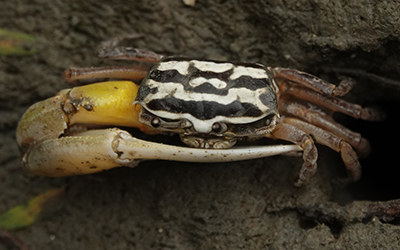

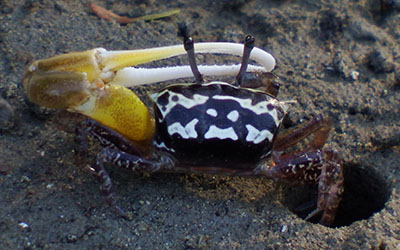
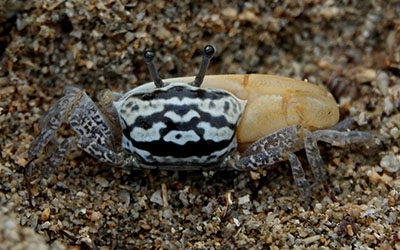
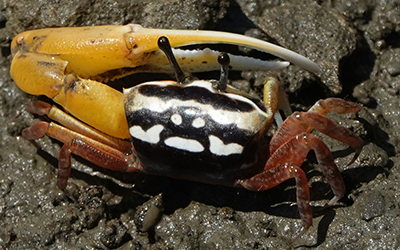
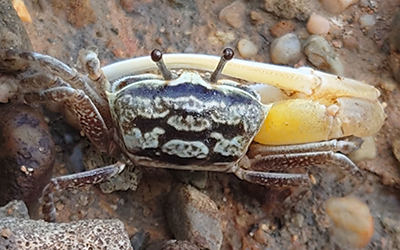
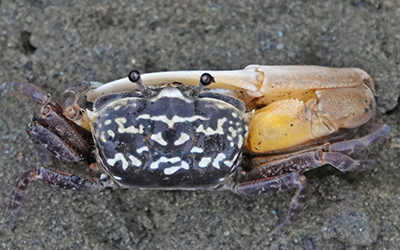
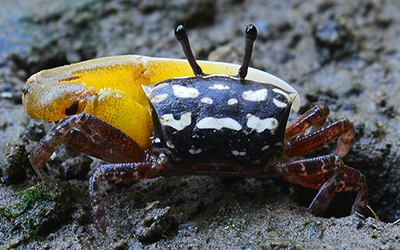
Another subtle difference is in the shape of the front corners of the carapace when seen from above (technically referred to as the anterolateral angles). These corners of the carapace are pointier (the angle is more acute) in Austruca perplexa than Austruca lactea. Compare the apparent sharpness of the front corners of the carapace in the above photos of Austruca perplexa to the more dull corners of Austruca lactea in the set below.
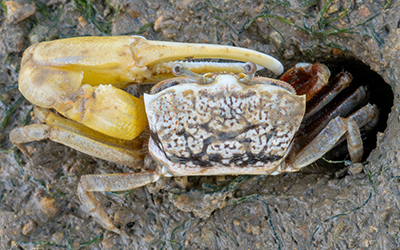
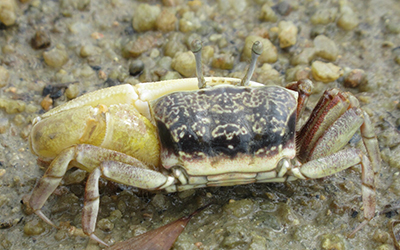
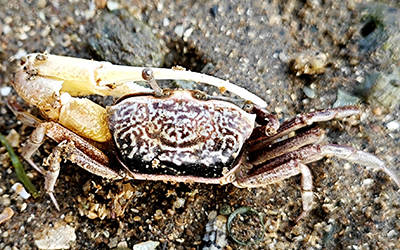
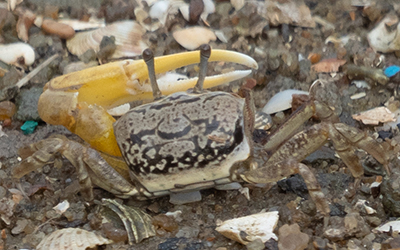
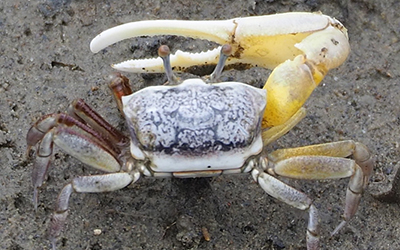
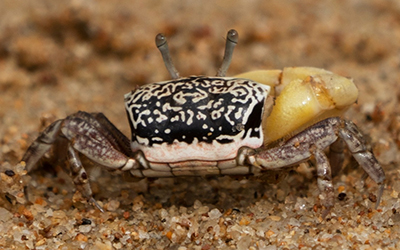
Austruca annulipes is a common, wide-spread species that is very similar to the previous two. Generally, the carapace of Austruca annulipes tends to be a mix of black and white. The large arm of Austruca annulipes is generally orange or red, with some of the color frequently found on the hand of the claw as well.
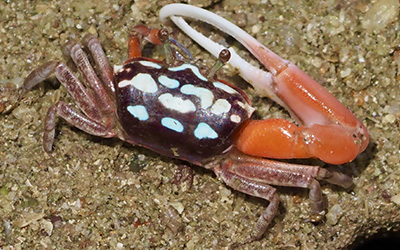
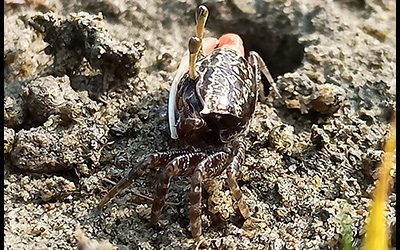
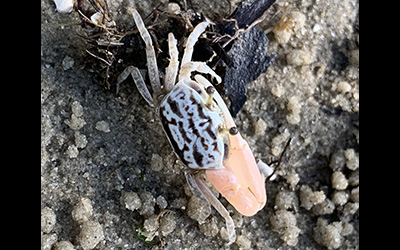
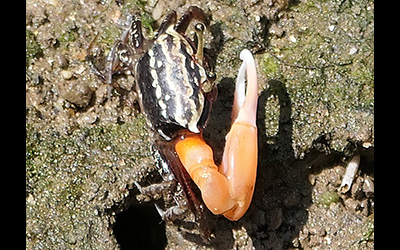
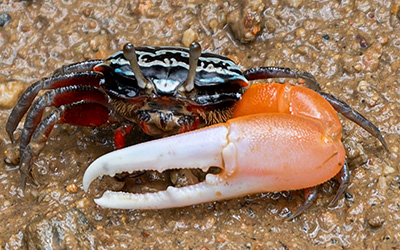
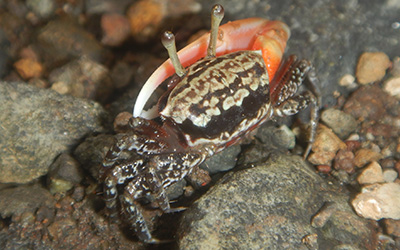
Austruca annulipes should be the easiest of the three to distinguish as it tends to have a reddish arm and claw, rather than the yellow or white, but like the previous two species, it will sometimes have entirely white claws.
Austruca triangularis is superficially similar in color to both Austruca lactea and Austruca perplexa, generally having a black/brow and white/cream carapace (occasionally yellow), frequently will broad stripes, and a claw which tends to be off white, but may include yellow. Despite this general similarity, the species should be relatively easy to tell apart.
There are at least three features which can be used to distinguish them. First, the carapace shape is noticably different, with the front corners of the carapace of Austruca triangularis extremely pointy and tending to point more toward the sides than the front, with the sides of the carapace converging much more strongly in Austruca triangularis than in either Austruca lactea or Austruca perplexa. Second, the hand of the large claw in Austruca triangularis is generally covered with brown spots, giving it a polka-dotted appearance (these spots are sometimes foundon the carapace as well). Third, but more subtle, on average Austruca triangularis tends to be smaller than the other two species, although there is overlap in size.
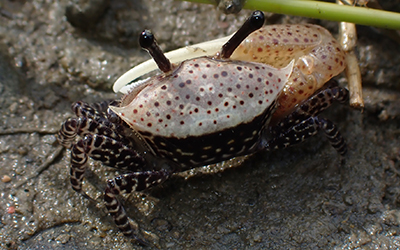
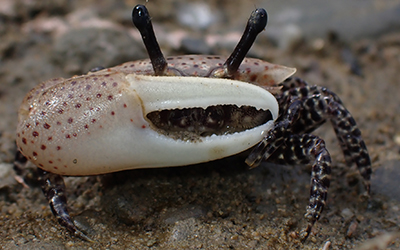
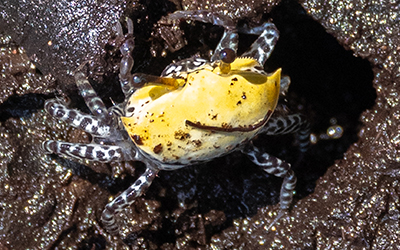
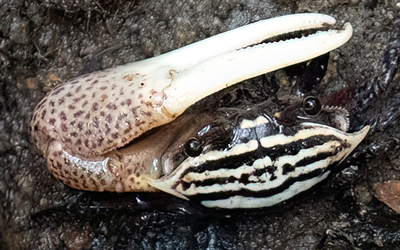
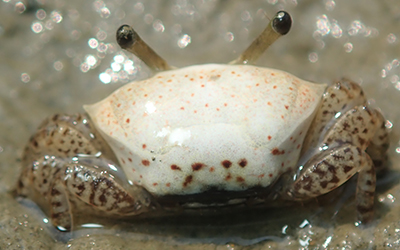
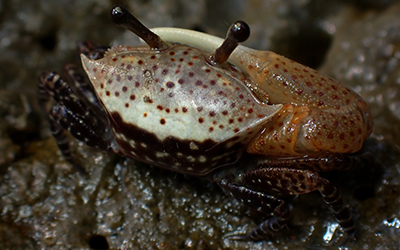

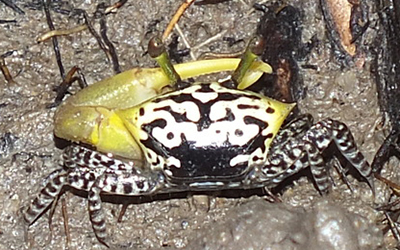
Paraleptuca splendida is the easiest of the five broad front species to identify. The carapace is generally a marbled aqua (blue) and black, sometimes with a patch of red behind the eyes; occasionally the blue fades to more of a tan color. The legs are usually red (although sometimes more blue/tan/black striped). The major claw of the males is red, with paler pink fingers. Most importantly, the eyestalks are almost always red or red-tinted. A broad-front with red eyestalks is generally sufficient to identify this species.
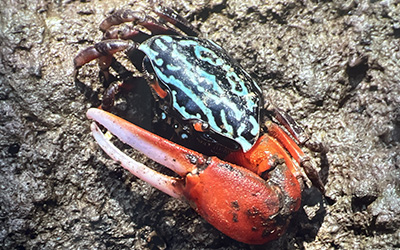
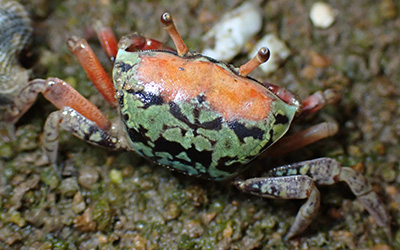
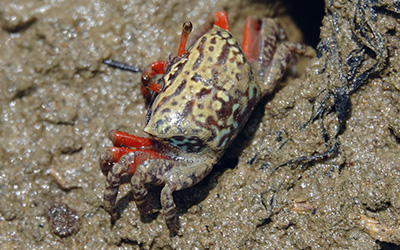
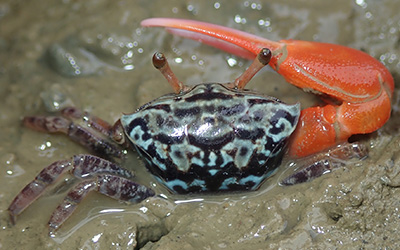
Tubuca typhoni is a distinct, poorly known species. Superficially it is similar in color to Paraleptuca splendida, but the two species are quite different even beyond the broad front vs. narrow front distinction.
Tubuca typhoni has a black and blue-to-purple carapace, with much more solid patches than the striping found in Paraleptuca splendida. In females, the carapace may be more of a solid reddish-purple. Its legs and eyestalks are generally a reddish-purple; its major claw is a similar color with some whitening along the tips of the fingers. The shape of the major claw is often more distinctly bowed than in Paraleptuca splendida and the ends of the fingers often end in a pair of flat surfaces rather than pointier tips. Eyestalk colors ranges from purple to red to gray.
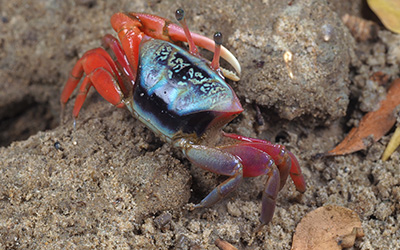
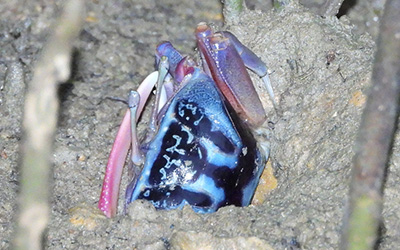
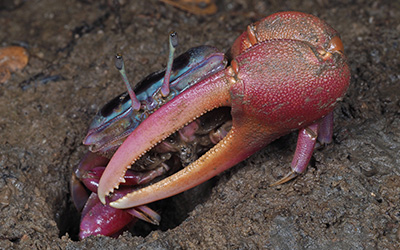
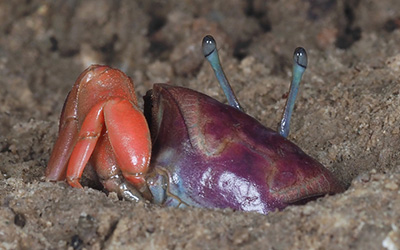
Gelasimus tetragonon is a wide-spread species that is something of an oceanic island specialist, although it is occasionally found on continental shores. It usually has a predominantly blue and black carapace with bright red legs (which occasionally may be darker) and gray eyestalks. The large claw of Gelasimus tetragonon is usually orange, with a noticeably darker red spot near the base of the pollex, and a white dactyl. Gelasimus tetragonon frequently has brown spots on the top part of the hand of the claw.
Gelasimus tetragonon has a lot of additional variability. In some places the carapace can lighten so that there is almost no blue, just a cream or pale orange with black markings. The pattern of the colors on the carapace can vary from stripes or blotches to tiny spots.
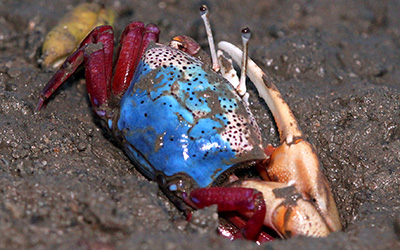
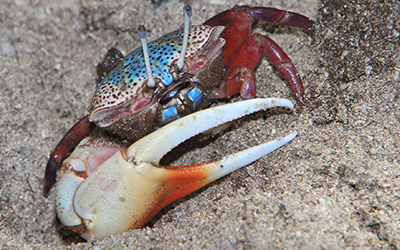
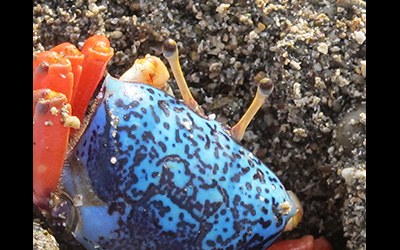
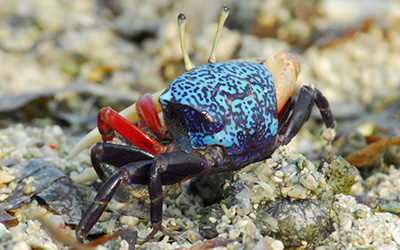
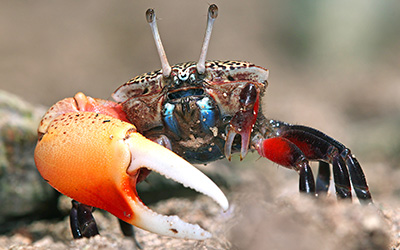
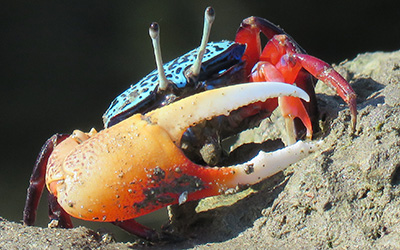
Tubuca rosea tends to be one of the more distinctively colored species. Its carapace is generally semi-translucent, frequently a pale blue or rose red (or both). Its limbs and large claw are generally rose red, with the fingers of the claw a bit paler.
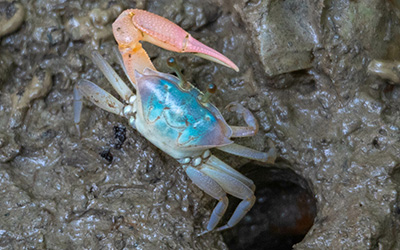
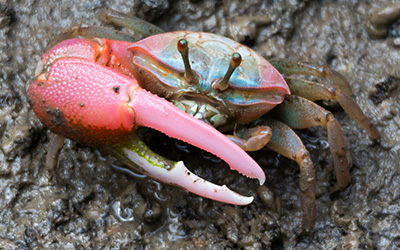

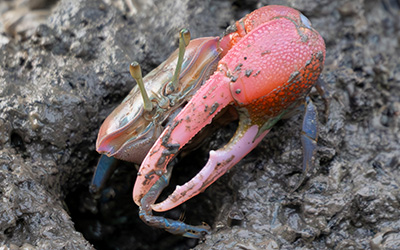
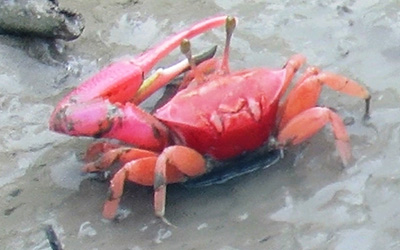
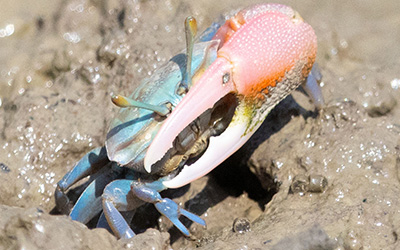
Tubuca forcipata is one of the more variable and confusing species, with multiple color forms that are not particularly similar to each other. One expert on fiddler crabs from the region has suggested that the name currently encompasses multiple, undescribed species being mixed together, but the formal work to determine if this is true and disentangle the various forms has not been completed at this time.
What I would refer to as the canonical form of Tubuca forcipata is a fiddler crab with a dark carapace with pale speckling (either white or pale blue) and a large claw where all or most of the hand is dark purple with the rest of the claw white. The claw is frequently heavily toothed and the tips of the fingers of the large claw often appear to come together as forceps, giving the species its name.
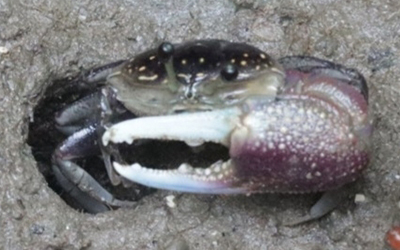
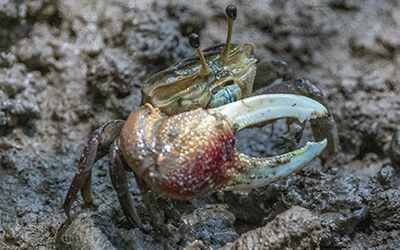
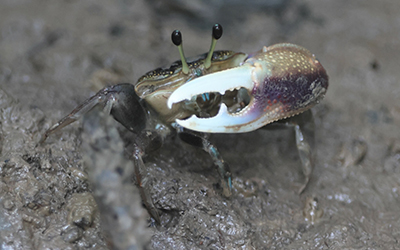
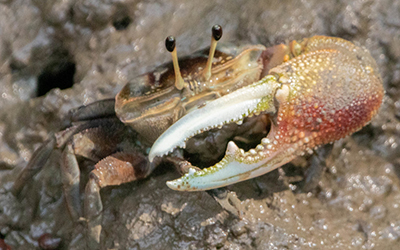
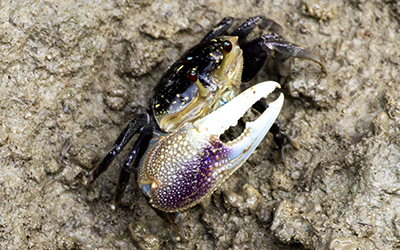
The second color form of Tubuca forcipata is completely different, with the crab a mix of black and bright red, generally with the black on the back half of the body and red on the front half, including the entire claw. The literature suggests that this bright red form is common in juveniles or yournger crabs of this species.
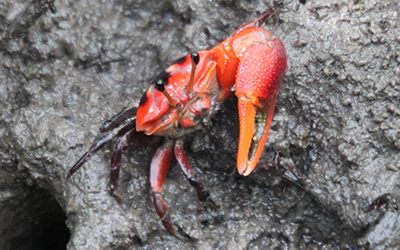
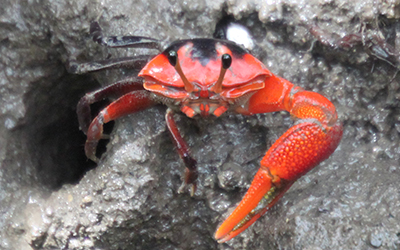
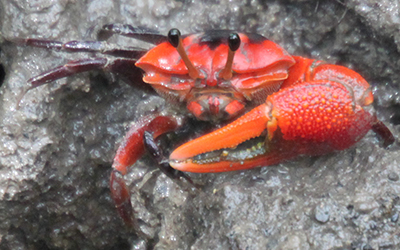
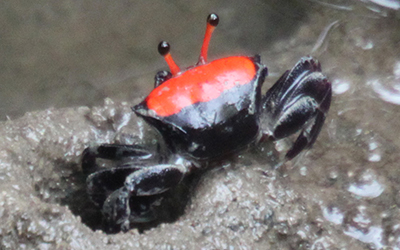
A third color form of Tubuca forcipata is vaguely in between the previous two, although not particularly similar to either of them. In this form, the carapace is generally black with large tan/beige patches toward the front, the legs are frequently pale gray, and the large claw has a dark red hand with orange fingers.
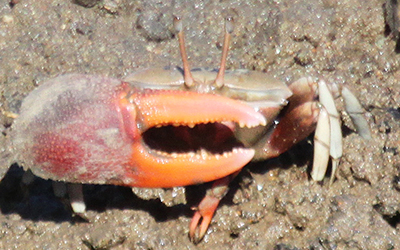

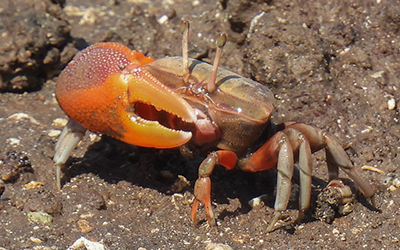
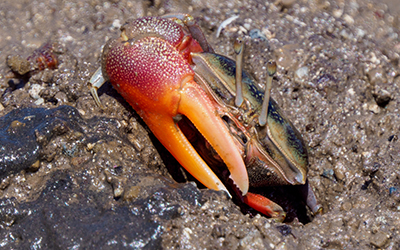
Are these all the same species? Maybe. It could simply be a variable species, the differences might represent age or developmental stage or regional variation. There are some additional patterns beyond color that separate these forms, particularly the first and third. The claw on the first form is notably toothier than the other two. The first and third form appear to have no geographic overlap, with the third form only appearing in the southeastern part of the Malay Archipelago (starting from Bali and including various islands further to the east and south), while the first form is only found further north and west (Borneo, Sumatra, etc.). Conversely, the black and red form (which has been suggested as representing a juvenile stage) overlaps with both of the other two in space, at least in part, as it has been seen from Bali (although not necessarily further south or east) to Singapore and the Malay peninsula.
Tubuca arcuata is among the most common species in eastern Asia and the near Pacific islands. The species it is most likely to be confused with, Tubuca acuta, will be described next.
The carapace of Tubuca arcuata is usually a mix of white and black, sometimes red and black, although in some individuals it may appear more solid white, black, or red. The black markings tend to be in large patches, often with a large stripe across the middle of the carapace and a second stripe toward the back of the carapace. The black sections will often appear speckled with the background color. In rarer instances, the white may appear more as a pale blue, particularly in juveniles; this blue is much paler than the bright blue of Tubuca paradussumieri. They generally have yellowish eyestalks with dark eyes.
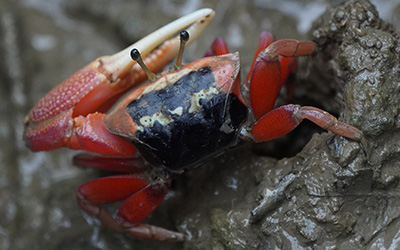

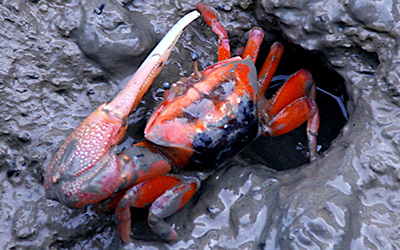

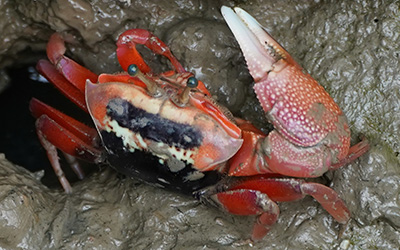
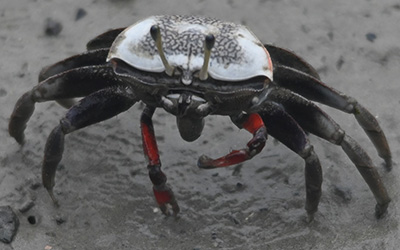
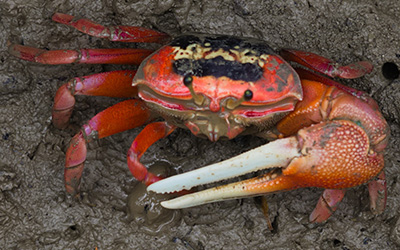
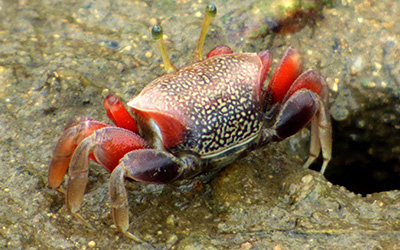
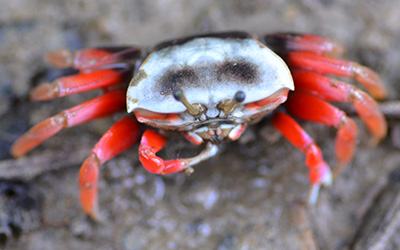
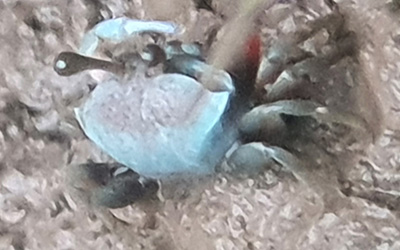
The limbs of Tubuca arcuata are usually red, sometimes black. The large claw is very robust, with distinct bumps on the outside. It is generally red, with white fingers. The fingers are usually distinctly curved and frequently meet with at the tips with flat inner surfaces. There will frequently be a distinct tooth about midway along the lower finger, and occasionally on the upper.
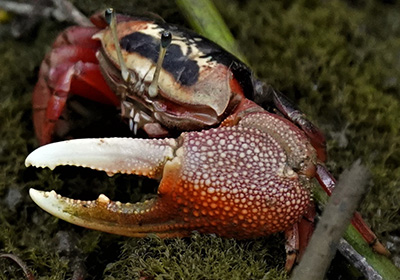
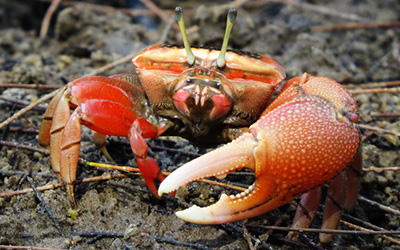
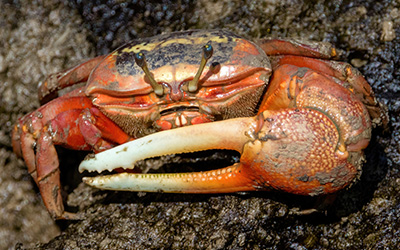
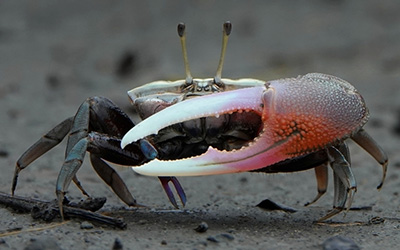
Tubuca acuta is generally similar in appearance to the more common Tubuca arcuata, with overall similar colors. As with the previous species, the carapace of Tubuca acuta is generally a mix of black and white, but the primary difference is in the patterning of the colors. In Tubuca arcuata there are commonly large patches of black on white, while the carapace of Tubuca acuta is more uniformly speckled. Contrast the photos below of Tubuca acuta with those of Tubuca arcuata above.
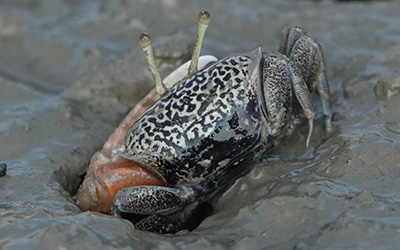
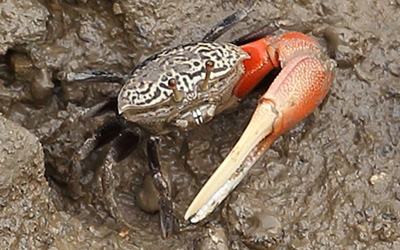
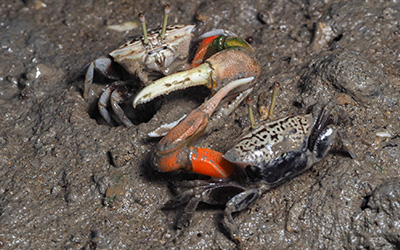
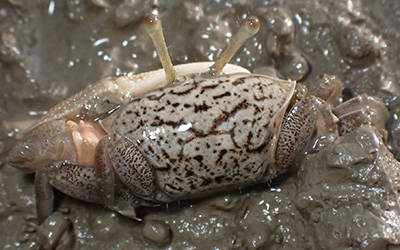
The limbs of Tubuca acuta tend to be black and white, but sometimes red, and the claw color tends to be an orange-red with white fingers. The claw structure is similar to Tubuca arcuata, but usually a bit less robust and smoother looking (less obvious bumps on the outside of the claw).
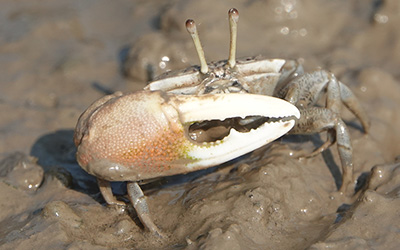
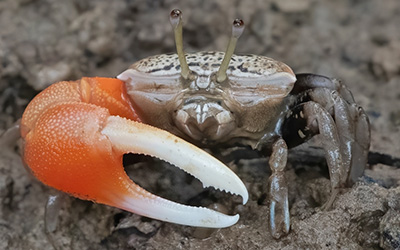
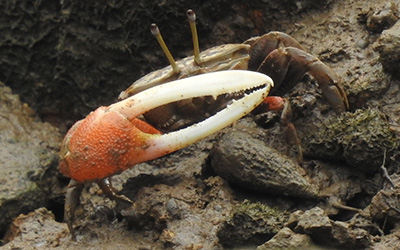
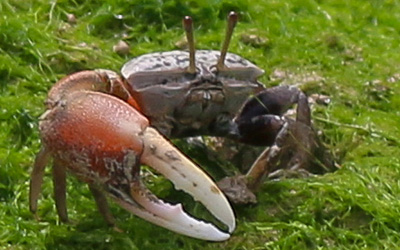
Tubuca arcuata can grow substantially larger than Tubuca acuta (approximately 3.5 vs 2.5 cm toward the upper end of their normal size range), but there is enough overlap that size will generally not be useful to distinguish them except for perhaps the very largest Tubuca arcuata. Both species are found essentially along the entirety of the Chinese coast, although Tubuca arcuata appears to be the much more common species.
Tubuca rhizophorae appears to be a generally rare species only found in limited parts of the southern half of the South China Sea. It is extremely similar to Tubuca acuta and the two species may be difficult to tell apart.
Tubuca rhizophorae has a cream carapace black marbling in relatively large blotches. The hand and arm of its large claw are a dull reddish-orange, while the fingers are entirely white. In some cases the fingers may be particularly long and smooth and come together with a flatter edge.
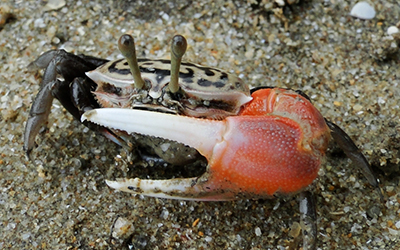
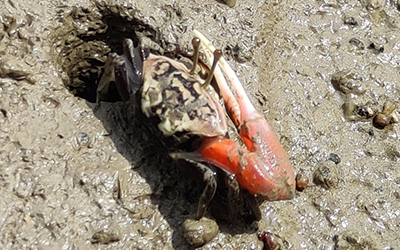

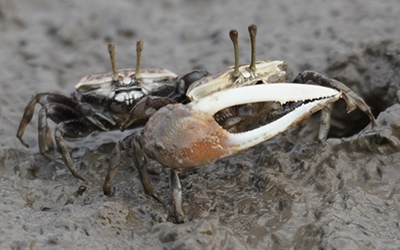
In terms of coloration, the carapace of Tubuca acuta tends to have dark speckling while Tubuca rhizophorae has larger dark blotches.
One very subtle difference between the two species, frequently not visible in photographs, is a difference in the shape of the groove in the front of the carapace (the front is the part of the carapace that extrudes between the eyestalks). In Tubuca rhizophorae, this groove tends to converge and narrow, while in Tubuca acuta the sides of this groove are more parallel.
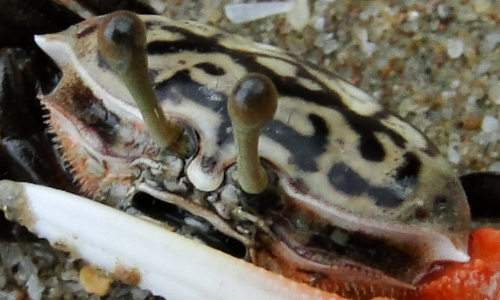
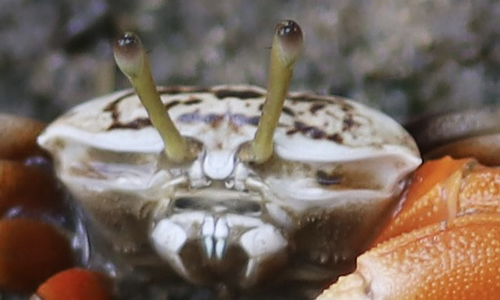
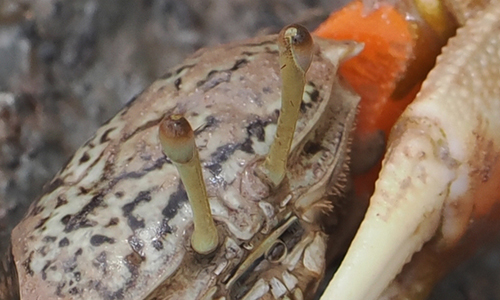
A possible final subtle difference is in general carapace shape. The sides of the carapace in Tubuca acuta are supposed to converge much more strongly than those of Tubuca rhizophorae. In looking at a lot of photos, I could not find what I would consider to be consistent differences in this shape, however, so I am slightly doubtful that this difference is reliable.
Tubuca paradussumieri is a strangely variable species, but still frequently identifiable in each of its varying forms. In one common form, adults are generally a rather dull color, with a faded blue-tan carapace (sometimes light, sometimes dark) and generally yellow-tan major claw. The shape of the claw in this form is quite distinct with extremely long fingers relative to other fiddler crabs. The claw shape alone can be used to identify the species in this form.
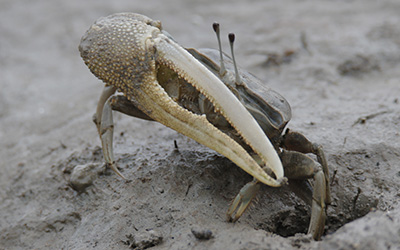
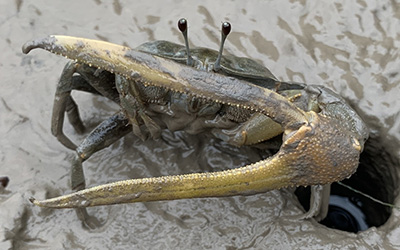
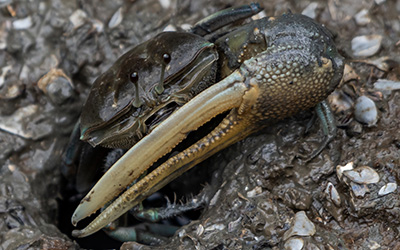
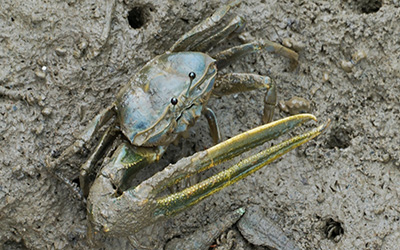
In contrast to the dull colors of these large adults, younger individuals in this species can be a brilliant cobalt blue, with much more typical-shaped claws lacking the overly long fingers. Some other related species from the genus Tubuca might also have a similar blue phase, so it is unclear how readily identifiable individuals of this shade are to the species level.
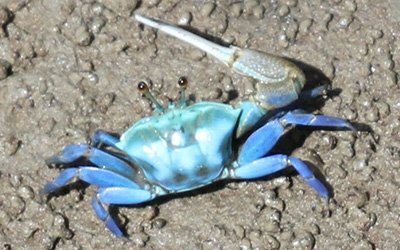
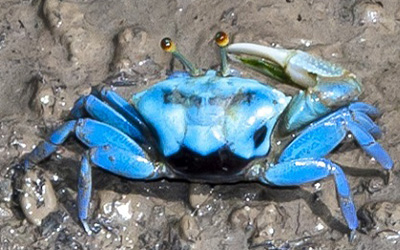
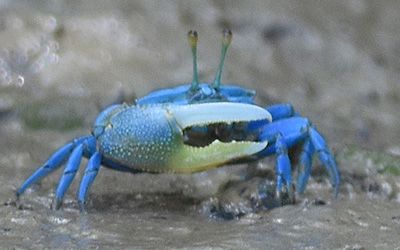
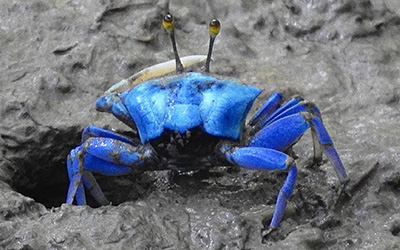
Tubuca dussumieri has a lot of similarities to Tubuca paradussumieri, but lacks the extreme variability. Tubuca dussumieri generally has a dark blue or black carapace, frequently solid colored although some spotting is possible, including occasional pale spots on the rear legs.
The large claw of male Tubuca dussumieri is generally two-toned, orange on the bottom and white on the top, with a darker orange/red patch at the base of the bottom finger. The fingers of the large claw tend to be fairly straight.
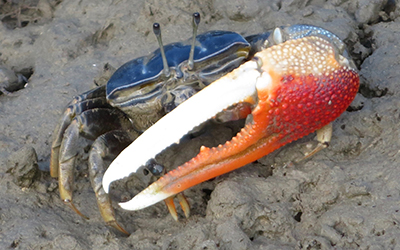
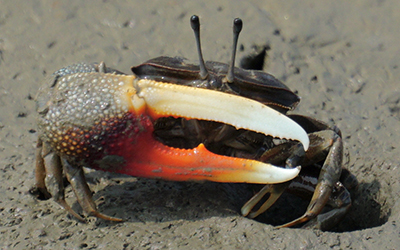
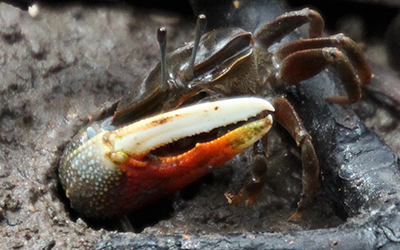
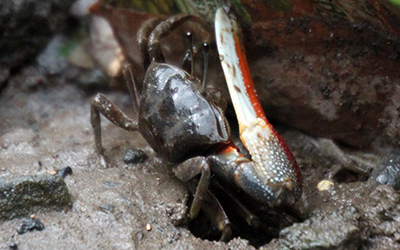
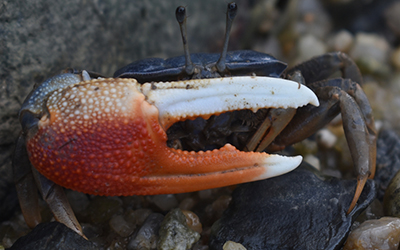
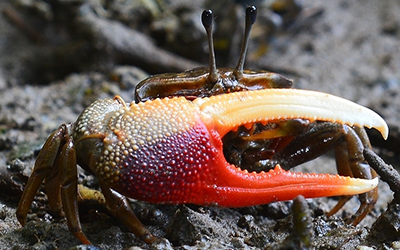
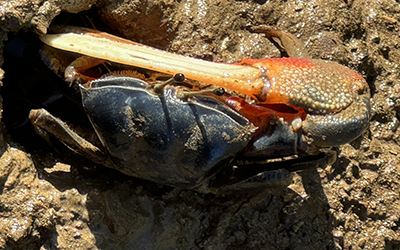
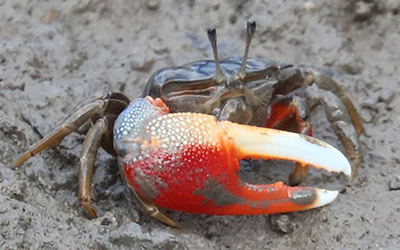
Tubuca paradussumieri is much more likely to have a large claw with the overly long fingers than Tubuca dussumieri. In general, the dark orange/red patch at the base of the lower finger in Tubuca dussumieri should be adequate to distinguish males of the two species.
Two species of the subgenus Gelasimus (Gelasimus) are likely found in this region. Gelasimus borealis would likely be found in the nothern part of the area, with Gelasimus vocans in the southern part of the area, but exactly where and how much they overlap is unclear.
Gelasimus borealis can be distinguished from most other species by both color and the structure of the large claw in males. The claw has a distinct shape only found in (most) species of the genus Gelasimus. Specifically, the upper finger tends to be moderately broad, tapering smoothly to a point, while the lower finger will usually curve upwards with a characteristic wave on the inner surface highlighting one to two large teeth. Individuals with regenerating claws will often lack much of this shape, but the claw still looks readily different from other species in the region.
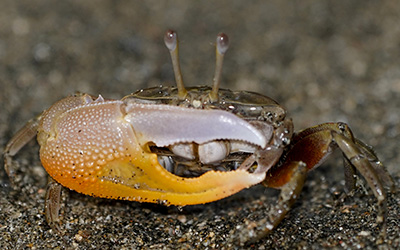
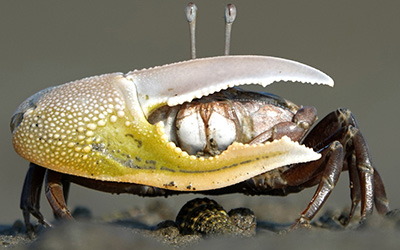
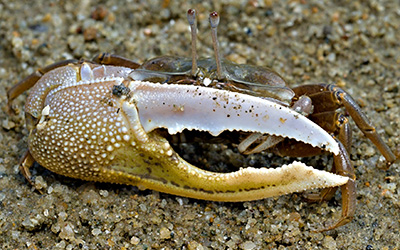
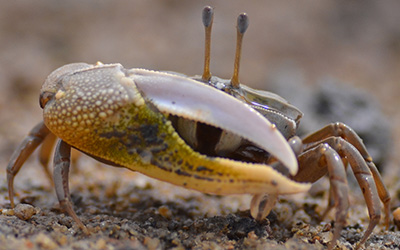
The color of Gelasimus borealis also differs from all of the other species. The carapace generally appears much more solidly colored or lightly marbled, rather than with the more dramatic patterns of other species; the color is frequently green or dark brown or white. The lower finger of the claw is typically yellow-green or orange, with the upper finger white or pink. The species entirely lacks the red common to all of the other narrow front species described so far (the orange on the claw will sometimes be reddish).
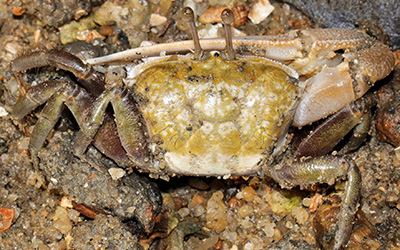
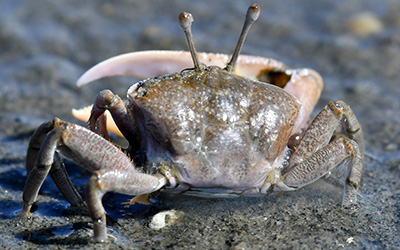
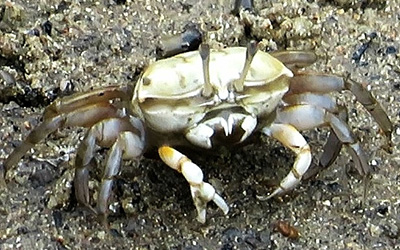
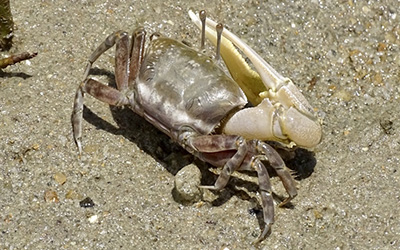
Gelasimus vocans and the previous species, Gelasimus borealis, are extremely similar, so much so that we lack reliable means of differentiating them in the field. There are some subtle differences, however, that may allow identification in some cases. On males of Gelasimus vocans with classic, unregenerated large claws, the tooth pattern on the lower finger is more striking and pronounced that found in Gelasimus borealis, where the teeth are never as striking; unfortunately regenerated claws are more likely to overlap in shape and structure across the two species. Compare more dramatic shape of lower finger of claw on the below photos to the more subtle shape of the previous species.

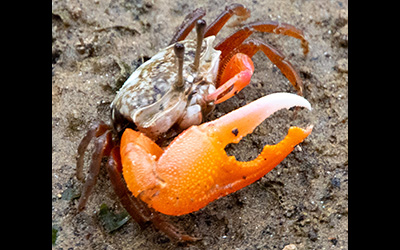

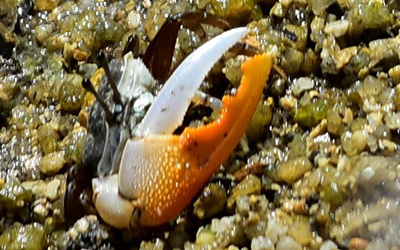
Another subtle difference which can also be seen in the above photos is that the color of Gelasimus borealis tends to be more dull, while that of Gelasimus vocans tends to be more bright and bold. Contrast the shades of orange on the claws of the two species.
A final very subtle difference which is difficult to see in the field and most photos is in the shape of the small claw on males (and both claws of females). In Gelasimus vocans the gap between the fingers of the small claw tends to be as wide or wider than the lower finger, while on Gelasimus borealis this gap tends to be narrower than the lower finger. Compare the gap in the small claws between these two sets of photos.
